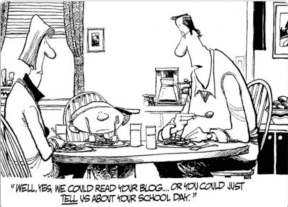While the term ‘generation gap’ often engenders negative relations between age groups, I propose a more constructive way of utilizing each group’s specialized skills.
A generation gap is defined as a difference in values and attitudes between one generation and another, especially between young people and their parents. Karl Mannheim (1893 Budapest – 1947 London), a founding father of classical sociology and generational theorist, further emphasized:
the rapidity of social change in youth was crucial to the formation of generations, and not every generation would come to see itself as distinct. In periods of rapid social change a generation would be much more likely to develop a cohesive character. He also believed a number of distinct sub-generations could exist.
As someone who was a youth during the 50s, 60s and 70s generation gap, I lived these differences in perceptions, behaviours and needs. Then, the breaking of an old mold was characterized by different language, clothing, hairstyles, music and beliefs. Bob Dylan’s lyrics echoed those changing times.
The Times They Are A-Changin’
Come gather round people
Wherever you roam
And admit that the waters
Around you have grown
And accept it that soon
You‘ll be drenched to the bone.
If your time to you
Is worth savin’
Then you better start swimmin’
Or you’ll sink like a stone
For the times they are a-changin’
Come mothers and fathers
Throughout the land
And don‘t criticize
What you can’t understand
Your sons and your daughters
Are beyond your command
Your old road is
Rapidly agein’.
Please get out of the new one
If you can’t lend a hand
For the times they are a-changin’.
Bob Dylan, copyright (c) 1963, 1991
Source: Liz Greene; 08 March 2011
Although the “flower power” generation’s most obvious contrast was with their parents, today’s generation gap is more finely demarcated. In her video, Learn about the New Generation Gap, youthologist Vanessa Van Petten spells out where she sees the dividing line. She aligns Generation X and Baby Boomers (their parents) on one side and Generation Y and Z on the other.
To better understand these two groupings, Gen Xers followed on the heels of the hippies and flower children, today’s Baby Boomers (born in the 1946-64 birth boom). Canadian author, Douglas Coupland (1991) popularized the term, Gen X, in his novel Generation X: Tales for an Accelerated Culture. In their 1991 book, Generations: The History of America’s Future, 1584 to 2069, William Strauss and Neil Howe applied additional labels to this “baby bust” generation of 30- and 40-year-olds.
Gen X (born between 1961-81)
- some were children during the spiritual awakening of the 60s and 70s
- reactive and nomadic
- pragmatic and perceptive but amoral and more interested in money than art
- more digitally savvy than their predecessors
- entered the work force as the first generation of knowledge workers
- most use a computer to do their job
Gen Ys or Millennials/Echo Boomers/Net Gens/Peter Pan Gens are described, in Strauss and Howe’s 2000 treatise, Millennials Rising: The Next Great Generation, as civic minded while rejecting the attitudes of the Baby Boomers and Gen Xs. As a GenY, Van Petten warns us their ability to take in more information more quickly means that understanding will be superficial, which is very likely why they seek development and mentoring in their workplaces.
Gen Y (early 1980s to late 90s/2000)
- multi-taskers extraordinaire
- peer-oriented – possibly due to their ease with communication technologies
- desire to communicate and seek acceptance – facilitated by involvement in virtual worlds of online games and communities
- fluent in digital technology utilization (computers, cell phones, MP3s)
- “great expectations” and assertive desire for feedback, responsibility and involvement in decision-making
- move from job to job on their quest to get their needs met
- more community and team oriented
Gen Zs, aka “digital natives,” are the only generation born into mass communication and media technologies. As Van Petten states “for Gen Zs, technology is not a choice, it is a way of being.”
Gen Z (early 1990s to early 2000s)
- more impatient and instant minded with even lower attention spans than their predecessors
- self-directed individualists who tend to lack in ambition
- lean toward risk-aversion and conformity as adults due to over-protection “during their formative years:
- from home, because of the rash of kidnappings and Amber Alerts;
- from school, because of school-shooting incidents; and
- from society, because of terrorism.” Monneke Jones
However, speculation about Gen Z is likely premature given their more recent arrival on the scene.
What is true, however, is Boomers, Xs, Ys and the first wave of Zs are increasingly finding themselves in the same workplace. The unique expectations and skill sets of the Ys and Zs have already impacted Human Resource recruitment and retention strategies.
As a Boomer, I acknowledge, “you raised your children well”. Greening of the environment and conscious consumerism are two social banners carried by Xs and Ys, respectively. There is no doubt that the trend toward corporate social responsibility lies with our youth refusing to work for or buy from companies employing unethical practices. I am grateful to them as someone who watched massive corporate layoffs in the 80s and 90s bring significant stress to our Canadian social network and health care systems. Tragically, the corporate world dumped these people onto the street where literally many of them have stayed—homeless and/or mentally ill.
So what needs to be done to bridge this generation gap before we become truly divided into “us and them” camps—repeating the anger and rebellion of the 60s?
To me, the key is bridge-building. My work with Gen Xers over the past five years has me believing this is their unique offering. They hold enough in common with both Boomers and Y/Zers that they can interpret and translate needs across the generational boundaries. Boomers—willing to collaborate across these boundaries—can mentor Xers through this intermediary role as well as provide Y/Zers with the developmental and participatory opportunities they desire. Is it any wonder that leadership coaching and emotional intelligence training are so prevalent in today’s organizations.
The value-add of four generations in one work place is the wonderful learning opportunities present for everyone. With a dose of patience and curiosity, “It’s all good!” How are you approaching this gap?





